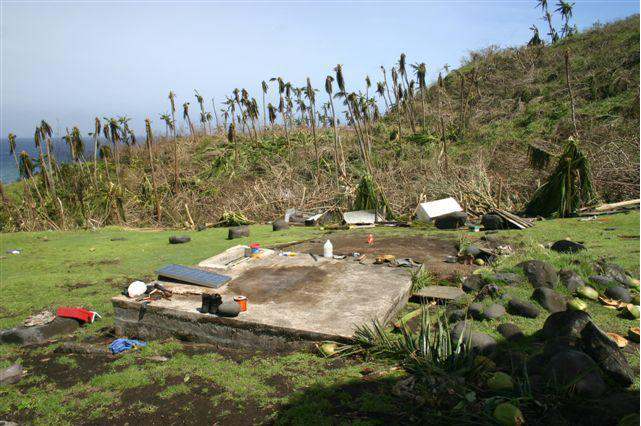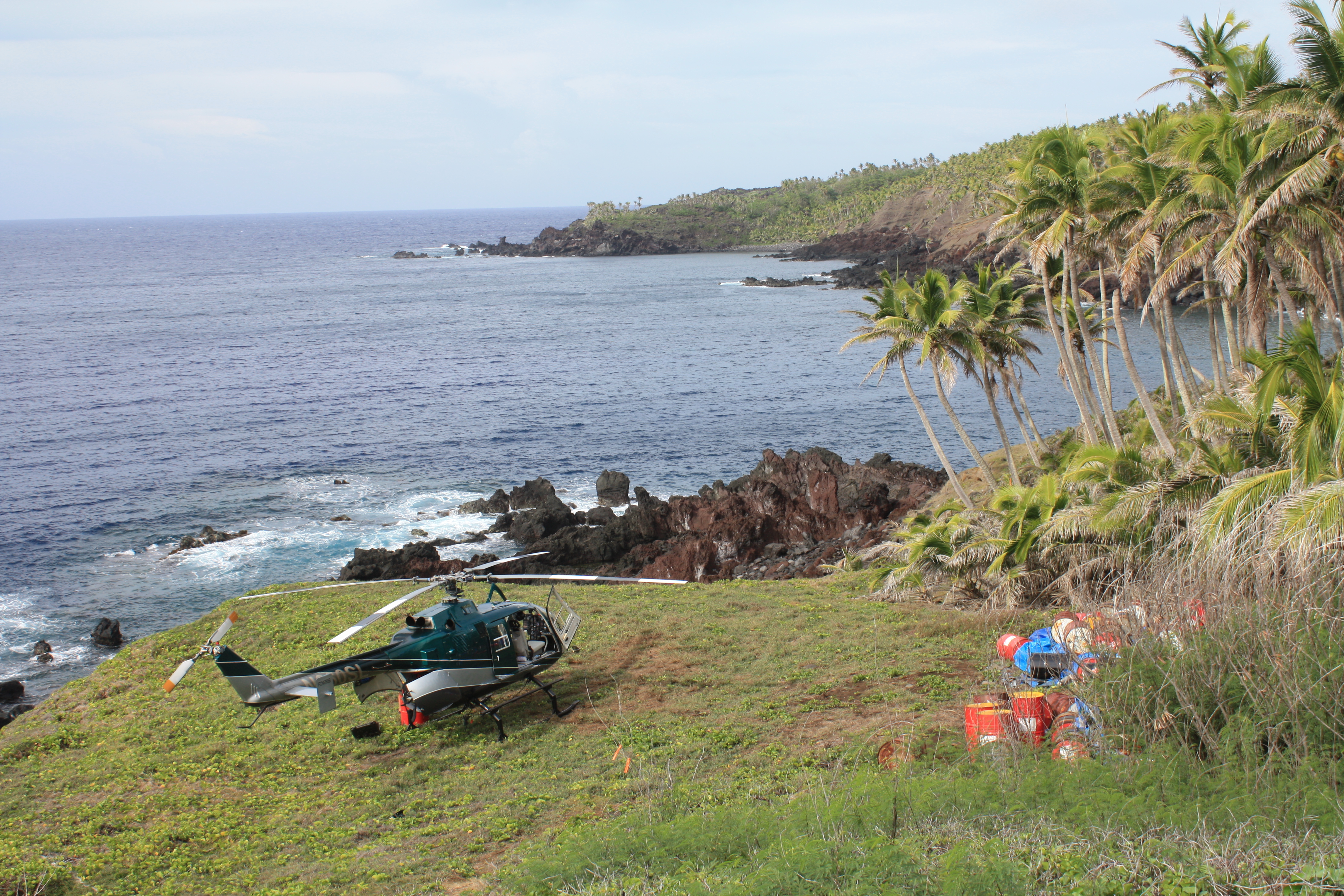|
Guguan
Guguan is an island in the Northern Mariana Islands in the Pacific Ocean. The island is currently uninhabited. Guguan is located south from Alamagan and north from Saipan, and is northeast from Sarigan. History Guguan was discovered in 1668 by the Spanish missionary Diego Luis de San Vitores, Diego Luis de Sanvitores who charted it as ''San Felipe''. It is likely that it was previously visited in 1522 by the Spanish sailor Castaway#Gonzalo de Vigo, Gonzalo de Vigo, deserter from the Ferdinand Magellan, Magellan expedition in 1521, who was the first European castaway in the history of the Pacific. Uninhabited at the time, in contrast to other islands in the Marianas it was never colonized. As with the other islands in the northern Marianna, Guguan was sold by Spain to the German Empire in 1899, and administered as part of German New Guinea. From 1909 to 1912, the island was leased to a Japanese company, who sent hunters to gather bird feathers for the European hat industry. Dur ... [...More Info...] [...Related Items...] OR: [Wikipedia] [Google] [Baidu] |
Northern Mariana Islands
The Northern Mariana Islands, officially the Commonwealth of the Northern Mariana Islands (CNMI; ch, Sankattan Siha Na Islas Mariånas; cal, Commonwealth Téél Falúw kka Efáng llól Marianas), is an unincorporated territory and commonwealth of the United States consisting of 14 islands in the northwestern Pacific Ocean.Lin, Tom C.W.Americans, Almost and Forgotten 107 California Law Review (2019) The CNMI includes the 14 northernmost islands in the Mariana Archipelago; the southernmost island, Guam, is a separate U.S. territory. The United States Department of the Interior cites a landmass of . According to the 2020 United States Census, 47,329 people were living in the CNMI at that time. The vast majority of the population resides on Saipan, Tinian, and Rota. The other islands of the Northern Marianas are sparsely inhabited; the most notable among these is Pagan, which for various reasons over the centuries has experienced major population flux, but formerly had res ... [...More Info...] [...Related Items...] OR: [Wikipedia] [Google] [Baidu] |
Commonwealth Of The Northern Mariana Islands
The Northern Mariana Islands, officially the Commonwealth of the Northern Mariana Islands (CNMI; ch, Sankattan Siha Na Islas Mariånas; cal, Commonwealth Téél Falúw kka Efáng llól Marianas), is an unincorporated territory and commonwealth of the United States consisting of 14 islands in the northwestern Pacific Ocean.Lin, Tom C.W.Americans, Almost and Forgotten 107 California Law Review (2019) The CNMI includes the 14 northernmost islands in the Mariana Archipelago; the southernmost island, Guam, is a separate U.S. territory. The United States Department of the Interior cites a landmass of . According to the 2020 United States Census, 47,329 people were living in the CNMI at that time. The vast majority of the population resides on Saipan, Tinian, and Rota. The other islands of the Northern Marianas are sparsely inhabited; the most notable among these is Pagan, which for various reasons over the centuries has experienced major population flux, but formerly had resident ... [...More Info...] [...Related Items...] OR: [Wikipedia] [Google] [Baidu] |
Northern Islands Municipality
Northern Islands Municipality is one of the four main political divisions of the Commonwealth of the Northern Mariana Islands. It consists of a long string of the northernmost islands of the Northern Marianas, including (from north to south) Farallon de Pajaros, the Maug Islands, Asuncion, Agrihan, Pagan, Alamagan, Guguan, Zealandia Bank, Sarigan, Anatahan, and Farallon de Medinilla. The total land area of the islands, including offshore islets and rocks, is 154.755 km² (59.75 sq mi). Population As of the 2010 census, the municipality is reported to be uninhabited. Pagan and Agrihan are known to have seasonal populations. Many Northern Island inhabitants have secondary residences on Saipan due to economic, educational or other needs. Some islands had also been evacuated due to volcanic activities such as in the case of Anatahan (2003) and Pagan (early 1980s). The mayor's office and municipality administration, traditionally in the village of Shomushon on Pagan, is now ... [...More Info...] [...Related Items...] OR: [Wikipedia] [Google] [Baidu] |
Alamagan
Alamagan is an island in the Northern Mariana Islands in the Pacific Ocean, north of Guguan, north of Saipan, and south of Pagan. It is currently uninhabited. History Alamagan was once settled by the Chamorros, who left behind archaeological evidence including stone columns (called latte stones) and ceramics. From a European perspective, Alamagan was discovered in 1669 by the Spanish missionary Diego Luis de San Vitores, who named it ''Concepción'' (Immaculate Conception in Spanish). It is likely that it was previously visited in 1522 by the Spanish sailor Gonzalo de Vigo, a deserter from the Magellan expedition in 1521 and the first European castaway in the history of the Pacific. In 1695, Alamagan's natives were forcibly removed to Saipan, and three years later to Guam. Following the sale of the Northern Marianas by Spain to the German Empire in 1899, Alamagan was administered as part of German New Guinea. During this time, a private firm, the Pagan Society, owned by a ... [...More Info...] [...Related Items...] OR: [Wikipedia] [Google] [Baidu] |
Sarigan
Sarigan is an uninhabited volcanic island in the Pacific Ocean. It is part of the Northern Mariana Islands, a U.S. territory. Sarigan is located northeast of Anatahan island, south of Guguan and north of Saipan, the largest island in the Northern Marianas. History Sarigan was originally settled by the Chamorros. The island was first charted by Europeans in late October 1543 by Spanish explorer Bernardo de la Torre on board of the carrack ''San Juan de Letrán'' when trying to return from Sarangani to New Spain. In 1695, the natives were forcibly removed to Saipan, and three years later to Guam. Following the sale of the Northern Marianas by Spain to the German Empire in 1899, Agrigan was administered as part of German New Guinea. The island was used as a penal colony from 1900-1906. The prisoners, who lived some with their families on Sarigan were mainly employed by the coconut plantations. In 1909, the island was leased by the Pagan Society, a German-Japanese partnership, whi ... [...More Info...] [...Related Items...] OR: [Wikipedia] [Google] [Baidu] |
Basalt
Basalt (; ) is an aphanite, aphanitic (fine-grained) extrusive igneous rock formed from the rapid cooling of low-viscosity lava rich in magnesium and iron (mafic lava) exposed at or very near the planetary surface, surface of a terrestrial planet, rocky planet or natural satellite, moon. More than 90% of all volcanic rock on Earth is basalt. Rapid-cooling, fine-grained basalt is chemically equivalent to slow-cooling, coarse-grained gabbro. The eruption of basalt lava is observed by geologists at about 20 volcanoes per year. Basalt is also an important rock type on other planetary bodies in the Solar System. For example, the bulk of the plains of volcanism on Venus, Venus, which cover ~80% of the surface, are basaltic; the lunar mare, lunar maria are plains of flood-basaltic lava flows; and basalt is a common rock on the surface of Mars. Molten basalt lava has a low viscosity due to its relatively low silica content (between 45% and 52%), resulting in rapidly moving lava flo ... [...More Info...] [...Related Items...] OR: [Wikipedia] [Google] [Baidu] |
Stratovolcano
A stratovolcano, also known as a composite volcano, is a conical volcano built up by many layers (strata) of hardened lava and tephra. Unlike shield volcanoes, stratovolcanoes are characterized by a steep profile with a summit crater and periodic intervals of explosive eruptions and effusive eruptions, although some have collapsed summit craters called calderas. The lava flowing from stratovolcanoes typically cools and hardens before spreading far, due to high viscosity. The magma forming this lava is often felsic, having high-to-intermediate levels of silica (as in rhyolite, dacite, or andesite), with lesser amounts of less-viscous mafic magma. Extensive felsic lava flows are uncommon, but have travelled as far as . Stratovolcanoes are sometimes called composite volcanoes because of their composite stratified structure, built up from sequential outpourings of erupted materials. They are among the most common types of volcanoes, in contrast to the less common shield volca ... [...More Info...] [...Related Items...] OR: [Wikipedia] [Google] [Baidu] |
Pyroclastic Flow
A pyroclastic flow (also known as a pyroclastic density current or a pyroclastic cloud) is a fast-moving current of hot gas and volcanic matter (collectively known as tephra) that flows along the ground away from a volcano at average speeds of but is capable of reaching speeds up to . The gases and tephra can reach temperatures of about . Pyroclastic flows are the most deadly of all volcanic hazards and are produced as a result of certain explosive eruptions; they normally touch the ground and hurtle downhill, or spread laterally under gravity. Their speed depends upon the density of the current, the volcanic output rate, and the gradient of the slope. Origin of term The word ''pyroclast'' is derived from the Greek (''pýr''), meaning "fire", and (''klastós''), meaning "broken in pieces". A name for pyroclastic flows which glow red in the dark is (French, "burning cloud"); this was notably used to describe the disastrous 1902 eruption of Mount Pelée on Martinique, a French ... [...More Info...] [...Related Items...] OR: [Wikipedia] [Google] [Baidu] |
Lava
Lava is molten or partially molten rock (magma) that has been expelled from the interior of a terrestrial planet (such as Earth) or a moon onto its surface. Lava may be erupted at a volcano or through a fracture in the crust, on land or underwater, usually at temperatures from . The volcanic rock resulting from subsequent cooling is also often called ''lava''. A lava flow is an outpouring of lava during an effusive eruption. (An explosive eruption, by contrast, produces a mixture of volcanic ash and other fragments called tephra, not lava flows.) The viscosity of most lava is about that of ketchup, roughly 10,000 to 100,000 times that of water. Even so, lava can flow great distances before cooling causes it to solidify, because lava exposed to air quickly develops a solid crust that insulates the remaining liquid lava, helping to keep it hot and inviscid enough to continue flowing. The word ''lava'' comes from Italian and is probably derived from the Latin word ''labes ... [...More Info...] [...Related Items...] OR: [Wikipedia] [Google] [Baidu] |
Pacific Ocean
The Pacific Ocean is the largest and deepest of Earth's five oceanic divisions. It extends from the Arctic Ocean in the north to the Southern Ocean (or, depending on definition, to Antarctica) in the south, and is bounded by the continents of Asia and Oceania in the west and the Americas in the east. At in area (as defined with a southern Antarctic border), this largest division of the World Ocean—and, in turn, the hydrosphere—covers about 46% of Earth's water surface and about 32% of its total surface area, larger than Earth's entire land area combined .Pacific Ocean . '' Britannica Concise.'' 2008: Encyclopædia Britannica, Inc. The centers of both the |
Micronesian Megapode
The Micronesian megapode or Micronesian scrubfowl (''Megapodius laperouse'') is an endangered megapode which inhabits islands of the Western Pacific Ocean. Description The Micronesian megapode is a stocky medium-sized bird that is mostly dark brownish-black in appearance. Its head is paler than its body, and it has a pale grey crest, a yellow bill, and large dull-yellow legs and feet. It is 38 cm. Medium-sized, dark megapode with paler head. Mostly brownish-black with short pale grey crest. Yellow bill, red facial skin showing through thin feathers. Unusually large, dingy yellow legs and feet. Similar spp. Could be confused with dark morphs of Red Junglefowl Gallus gallus (or feral domestic stock). . Its call is a loud "keek", song often a duet with one bird beginning a rising and accelerating "keek-keek-keek-keek"- etc. culminating in a loud "kee-keer-kew" (Palau) or "keek-keer-keet" (Marianas), the other answering with a rising cackle that slows near the end. . The Micr ... [...More Info...] [...Related Items...] OR: [Wikipedia] [Google] [Baidu] |








.jpg)
.jpg)